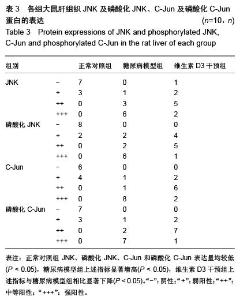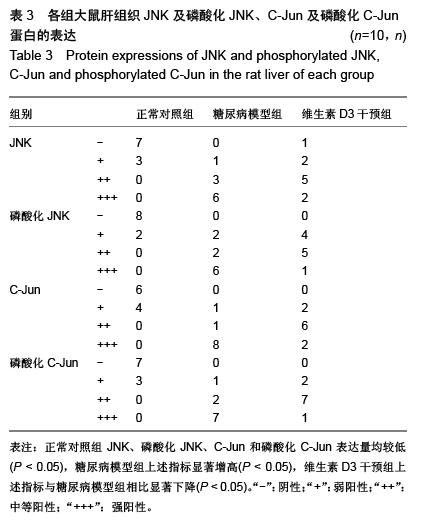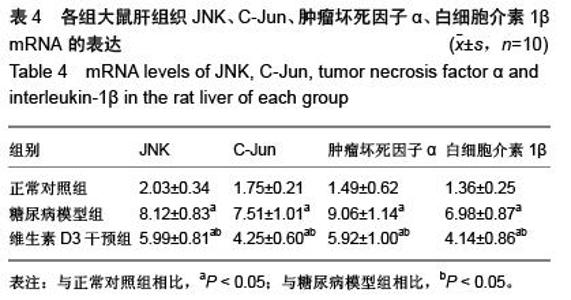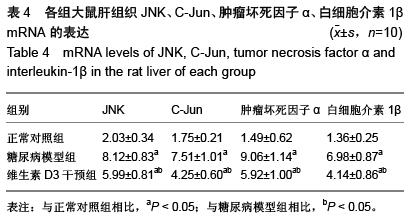| [1] Fukuda K, Seki Y, Ichihi M, et al. Usefulness of ultrasonographic estimation of preperitoneal and subcutaneous fat thickness in the diagnosis of nonalcoholic fatty liver disease in diabetic patients. J Med Ultrason. 2015; 42(3):357-363.
[2] Navarro-González JF, Mora-Fernández C. The role of inflammatory cytokines in diabetic nephropathy. J Am Soc Nephrol. 2008;19(3):433-442.
[3] Jain SK, Kannan K, Lim G, et al. Elevated blood interleukin-6 levels in hyperketonemic type 1 diabetic patients and secretion by acetoacetate-treated cultured U937 monocytes. Diabetes Care. 2003;26(7):2139-2143.
[4] Lekshmi RK, Rajesh R, Mini S. Ethyl acetate fraction of Cissus quadrangularis stem ameliorates hyperglycaemia- mediated oxidative stress and suppresses inflammatory response in nicotinamide/streptozotocin induced type 2 diabetic rats. Phytomedicine. 2015;22(10): 952-960.
[5] Sharfi H, Eldar-Finkelman H. Sequential phosphorylation of insulin receptor substrate-2 by glycogen synthase kinase-3 and c-Jun NH2-terminal kinase plays a role in hepatic insulin signaling. Am J Physiol Endocrinol Metab. 2008;294(2): E307-E315.
[6] Wolden-Kirk H, Overbergh L, Christesen HT, et al. Vitamin D and diabetes: its importance for beta cell and immune function. Mol Cell Endocrinol. 2011;347(1):106-120.
[7] Li H, Xie H, Fu M, et al. 25-hydroxyvitamin D3 ameliorates periodontitis by modulating the expression of inflammation- associated factors in diabetic mice. Steroids. 2013;78(2): 115-120.
[8] Meeker S, Seamons A, Paik J, et al. Increased dietary vitamin D suppresses MAPK signaling, colitis, and colon cancer. Cancer Res. 2014;74(16):4398-4408.
[9] Moore M, Piazza A, Nolan Y, et al. Treatment with dexamethasone and vitamin D3 attenuates neuroinflammatory age-related changes in rat hippocampus. Synapse. 2007;61(10):851-861.
[10] Korf H, Wenes M, Stijlemans B, et al. 1, 25-Dihydroxyvitamin D3 curtails the inflammatory and T cell stimulatory capacity of macrophages through an IL-10-dependent mechanism. Immunobiology. 2012;217(12):1292-1300.
[11] 赵小强,权莉,杜国利,等. 1,25-(OH)2D3对2型糖尿病大鼠肝脏的保护作用[J].中华肝脏病杂志,2013,21(10):778-780.
[12] Wu L, Juan C, Hwang LS, et al. Green tea supplementation ameliorates insulin resistance and increases glucose transporter IV content in a fructose-fed rat model. Eur J Nutr. 2004;43(2):116-124.
[13] 龙玲莉,郑淑慧,李宇彬.灯盏花素干预糖尿病模型大鼠睾丸组织增殖细胞核抗原和c-fos的表达[J].中国组织工程研究,2015, 19(18):2917-2922.
[14] 于洋,郑石磊,刘学政.链脲佐菌素联合高脂饲养诱导2型糖尿病模型大鼠模型的稳定性及其眼病特点[J].中国组织工程研究, 2015,19(27):4389-4393.
[15] 蒋升,谢自敬,张莉.链脲佐菌素诱导1型糖尿病大鼠模型稳定性观察[J].中国比较医学杂志,2006,16(1):16-18.
[16] Mezza T, Muscogiuri G, Sorice GP, et al. Vitamin D deficiency: a new risk factor for type 2 diabetes. Ann Nutr Metab. 2012; 61(4):337-348.
[17] McGill A, Stewart JM, Lithander FE, et al. Relationships of low serum vitamin D3 with anthropometry and markers of the metabolic syndrome and diabetes in overweight and obesity. Nutr J. 2008;7(1):4.
[18] Arkan MC, Hevener AL, Greten FR, et al. IKK-β links inflammation to obesity-induced insulin resistance. Nat Med. 2005;11(2):191-198.
[19] Solinas G, Vilcu C, Neels JG, et al. JNK1 in hematopoietically derived cells contributes to diet-induced inflammation and insulin resistance without affecting obesity. Cell Metab. 2007; 6(5):386-397.
[20] Bage T, Lindberg J, Lundeberg J, et al. Signal pathways JNK and NF-κB, identified by global gene expression profiling, are involved in regulation of TNF-α-induced mPGES-1 and COX-2 expression in gingival fibroblasts. BMC genomics. 2010;11(1):241.
[21] Tarantino G, Caputi A. JNKs, insulin resistance and inflammation: a possible link between NAFLD and coronary artery disease. World J Gastroenterol. 2011;17(33):3785.
[22] Ning C, Liu L, Lv G, et al. Lipid metabolism and inflammation modulated by Vitamin D in liver of diabetic rats. Lipids Health Dis. 2015;14(1):31.
[23] Martinovi? V, Grigorov I, Bogojevi? D, et al. Activation level of JNK and Akt/ERK signaling pathways determinates extent of DNA damage in the liver of diabetic rats. Cell Physiol Biochem. 2012;30(3):723-734.
[24] Epstein FH, Tilg H, Diehl AM. Cytokines in alcoholic and nonalcoholic steatohepatitis. N Engl J Med. 2000;343(20): 1467-1476.
[25] Negrin KA, Flach R JR, DiStefano MT, et al. IL-1 signaling in obesity-induced hepatic lipogenesis and steatosis. PLoS One. 2014;9(9):e107265.
[26] Al-Shoumer KA, Al-Essa TM. Is there a relationship between vitamin D with insulin resistance and diabetes mellitus? World J Diabetes. 2015;6(8):1057.
[27] Kostoglou-Athanassiou I, Athanassiou P, Gkountouvas A, et al. Vitamin D and glycemic control in diabetes mellitus type 2. Ther Adv Endocrinol Metab. 2013;4(4):122-128.
[28] Calvo-Romero JM, Ramiro-Lozano JM. Metabolic effects of supplementation with vitamin D in type 2 diabetic patients with vitamin D deficiency. Diabetes Metab Syndr. 2015.
[29] Sung C, Liao M, Lu K, et al. Role of vitamin D in insulin resistance. J Biomed Biotechnol. 2012.
[30] Maestro B, Dávila N, Carranza MC, et al. Identification of a Vitamin D response element in the human insulin receptor gene promoter. J Steroid Biochem Mol Biol. 2003;84(2): 223-230.
[31] Jorde R, Grimnes G. Vitamin D and metabolic health with special reference to the effect of vitamin D on serum lipids. Prog Lipid Res. 2011;50(4):303-312.
[32] 阳琰,高琳,晏永慧,等.1, 25-二羟维生素D3对实验糖尿病大鼠模型肝脏中三酰甘油含量的影响及其机制探讨[J].中华内分泌代谢杂志,2014,30(12):1115-1119.
[33] Wamberg L, Kampmann U, Stødkilde-Jørgensen H, et al. Effects of vitamin D supplementation on body fat accumulation, inflammation, and metabolic risk factors in obese adults with low vitamin D levels-results from a randomized trial. Eur J Intern Med. 2013;24(7):644-649. |





